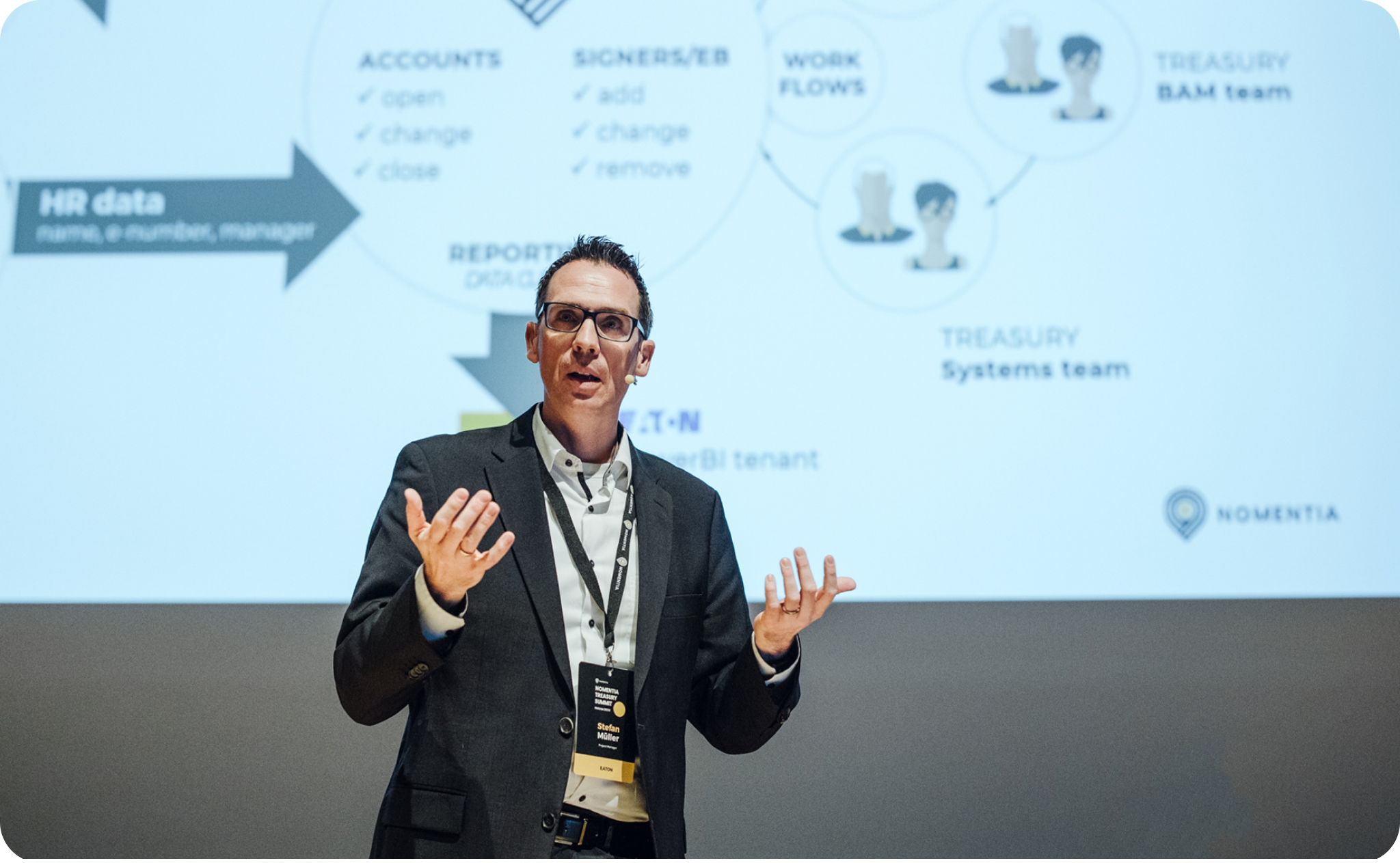Navigating the dynamics of modern treasury management in 2024
Insights from the Nomentia Treasury Summit
As Bob Dylan put it: “The times they are a changing.” In today’s volatile business environment, there’s no questioning the pivotal role effective treasury management plays in ensuring financial stability and facilitating strategic decision-making. That said, gray, wet, and slippery Helsinki in Mid-March may not immediately awe and inspire people to think proactively, but when the 2nd annual Nomentia Treasury Summit brought industry leaders and experts together to explore the intricacies of modern treasury management, the environmental insipidity could easily be forgiven.

Treasury management – For the future
In an engaging opening address, Nomentia’s own Lauri Bergström and Tapani Oksala painted a vivid tableau of the ever-evolving landscape of treasury management and Nomentia’s customer-centric and dynamic approach to its developments. Three key trends emerged as focal points: financial strategy, risk management, and technological advances. Emphasizing the critical role of teamwork and leadership across organizations, the duo set up a robust foundation for the summit’s discussions.
Unlocking liquidity management: The story of Caverion and the dynamics after an M&A
The event kicked off in full with a deep dive into the complexities of liquidity management, as exemplified by Caverion’s finance operations amidst a strategic merger. In this session, Viljami Vainikka, Head of Group Treasury at Caverion, provided a comprehensive overview of Caverion’s liquidity landscape during a merger with Assemblin, highlighting their approach to optimizing cash visibility and addressing challenges in cash flow forecasting. He outlined Caverion’s liquidity management setup, which includes cash management across multiple currencies, numerous bank accounts, and entities, with a focus on optimizing liquidity and improving forecast accuracy.

In conversation with Tapani Oksala, Vainikka shed light on the challenges of optimizing cash visibility and underscored the importance of robust and accurate cash forecasting, leveraging technology and strategic partnerships, and the potential for integrating AI to enhance liquidity planning processes to increase efficiency and accuracy.
-
Key takeaways from “Unlocking liquidity management”
-
Importance of predictive analytics: Leveraging predictive analytics can significantly enhance forecast accuracy and reduce reliance on manual adjustments, thereby improving the efficiency and reliability of cash flow forecasting processes.
-
Data quality and integration: Ensuring the availability and quality of data is crucial for effective liquidity management. Integrating data from various sources, including ERP systems and bank statements, enables comprehensive analysis and informed decision-making.
-
Optimizing forecasting processes: Caverion's approach to liquidity management involves optimizing cash flow forecasting processes across different timeframes. By utilizing historical data, statistical models, and machine learning techniques, organizations can develop more accurate and reliable forecasts.
-
Collaborative approach: Effective liquidity management necessitates collaboration among treasury, business control, and IT teams. Aligning goals and objectives, selecting appropriate data, and implementing suitable statistical models are essential steps in the forecasting process.
-
Continuous improvement: Implementing predictive analytics for liquidity management is an ongoing process that requires continuous evaluation and adjustment. Organizations must be prepared to adapt their models and methodologies based on evolving market conditions and business requirements.
How BioNTech dealt with turbulent times
In the second presentation of the Nomentia Treasury Summit, Dirk Schreiber, Head of Treasury at BioNTech, shared with the audience insights into BioNTech’s journey amidst the centennially turbulent times leading toward the COVID-19 pandemic and its aftermath.

Founded in 2008, BioNTech experienced initial challenges until the onset of the COVID-19 pandemic in early 2020. Recognizing the potential of their mRNA technology for developing a COVID-19 vaccine, BioNTech swiftly pivoted its focus, leading to the rapid development and distribution of a vaccine in collaboration with Pfizer.
Schreiber highlighted the unprecedented growth and financial influx that followed the successful vaccine development, presenting BioNTech's treasury management journey in response to these dynamic circumstances. With a surge in funds, BioNTech urgently required a robust treasury management system to manage its expanding financial operations. Despite facing initial challenges with an untested treasury function, Schreiber and his team swiftly implemented a treasury management system, leveraging Nomentia's expertise to build BioNTech's treasury operations.
The presentation explored the intricacies of BioNTech’s treasury transformation, emphasizing the rapid expansion of requirements for the treasury and the establishment of essential treasury guidelines and processes for future development. Schreiber emphasized the critical role of the right technology in this transformation, particularly the implementation of Nomentia's treasury management system to provide real-time visibility into cash positions, automate trading activities, and streamline reporting processes.
-
Key takeaways from “How BioNTech dealt with turbulent times”
-
Swift adaptation amidst rapid growth: BioNTech’s agile response to its rapid growth underscored the importance of proactive treasury management in times of uncertainty.
-
Strategic implementation of treasury management systems: The prompt implementation of a treasury management system played a crucial role in BioNTech’s ability to efficiently manage its financial operations amidst extreme pressure to expand, highlighting the significance of advanced technology in modern treasury management.
-
Trust and collaboration: Schreiber emphasized the importance of trust and collaboration not only within the organization but with its most important strategic partners to navigate the company through unprecedented challenges.
-
Schreiber concluded his presentation by reflecting on the success of BioNTech’s treasury transformation, acknowledging the collaborative effort that led to the project’s recognition with the “Treasury of the Year Award 2023” in Germany.
Panel discussion: Bank as your partner in the fight against financial crime
The panel discussion featuring representatives from Nordea, SEB, and OP shed light on the evolving landscape of financial crime prevention and the role of banks as strategic partners.

Against the backdrop of increasing cybersecurity threats, the panel emphasized the importance of collaboration between banks and corporate treasuries in combating financial crime.
As technology evolves, it brings with it new and exciting opportunities to those companies that are able to manage their risk appetite accordingly. Unfortunately, the development of technology also provides opportunities to the criminal element. The threat landscape in the digitalized business environment is significantly more complex than before. Thanks to technology we’re living in an environment wrought with crime and fraudulent behavior. The ecosystem of crime in the digitalized financial environment is complex and ever more susceptible to human error and poor processes.
The panel’s discussions centered on the adoption of innovative technologies and best practices for enhancing security and mitigating risk in treasury operations. This session focused on the crucial role of proactive measures and strategic partnerships in safeguarding financial assets in an increasingly digital world.
According to the panel, treasury management and financial professionals would do well not to treat the fight against financial crime as a digital problem only, as the evolving threat landscape requires an adaptive and nimble approach not only to security technology but the organizational culture as well.
Fortunately, this is not a fight that businesses have to face on their own. The banking and finance industry has taken proactive steps to improve its resilience and business continuity.
On the legislative side, the EU’s DORA (Digital Operations Resilience Act) is a great example of how demands for businesses to secure their operations in the financial threat landscape is not only a digital undertaking but requires a wider scope that encompasses their operations fully.
-
Key takeaways from “Bank as your partner in the fight against financial crime”
-
Heightened cyber threats in the digital economy: The digitalization of finance and treasury management has brought unprecedented opportunities but also increased vulnerabilities. Cyber threats such as phishing scams, ransomware, and state-sponsored attacks are on the rise, necessitating proactive strategies to protect financial assets and operations.
-
Evolution of treasury management: The digital age has revolutionized treasury management with automated systems and real-time analytics. However, increased reliance on technology requires robust cybersecurity measures to safeguard against emerging threats like ransomware and supply chain attacks.
-
Holistic cybersecurity approach: Finance and treasury functions must adopt a multi-dimensional approach to cybersecurity that encompasses digital, physical, and cultural dimensions. This includes implementing technical measures, ensuring physical security, and fostering a security-conscious organizational culture.
-
Regulatory response: Regulatory frameworks like the European Union's Digital Operational Resilience Act (DORA) aim to enhance the operational resilience of the financial sector by establishing principles for managing cyber risks, monitoring third-party providers, conducting resilience testing, and facilitating information sharing.
-
Industry collaboration: Collaboration and knowledge-sharing among banks, companies, and other stakeholders are crucial for fostering industry-wide resilience against cyber threats. By pooling resources and expertise, stakeholders can collectively address emerging challenges and safeguard the integrity of the financial system.
Digitalizing bank account management with smart workflows at EATON
In the 4th presentation of the day, Stefan Müller from Eaton discussed the digitalization of bank account management (BAM) during the Nomentia's Treasury Summit. Previously, BAM was cumbersome and fragmented, involving manual tasks, email exchanges, and Excel spreadsheets. Eaton recognized the inefficiencies and partnered with Nomentia in 2019 to modernize their BAM processes.

The transformation involved leveraging advanced digital technologies to automate tasks like account openings, closures, signatory changes, and transaction monitoring. This shift required comprehensive cleanup of account and signer data, process documentation, and target workflows. By mid-2021, the project was underway, and by March 2022, the new BAM system was live.
Today, Eaton manages BAM operations on one centralized platform, gaining efficiency, control, and compliance. Automated reconciliations and streamlined workflows have reduced manual efforts significantly. The treasury function has seen tangible benefits, including the closure of 200 accounts and the removal of over 200 signers and 2,300 permissions.
The digitalization of treasury operations has offered opportunities for greater control and efficiency. Real-time data access enables informed decision-making and proactive risk management. Automation of routine tasks frees up time for strategic analysis. However, increased reliance on digital platforms necessitates robust security protocols to mitigate cybersecurity risks.
-
Key Takeaways from “Digitalizing bank account management with smart workflows at EATON”
-
Digital transformation of BAM: Eaton embraced digitalization with Nomentia to modernize bank account management, reducing manual efforts and streamlining processes.
-
Efficiency and control: The shift to automated systems and streamlined workflows can significantly enhance efficiency and control over account-related activities, leading to faster operations and improved compliance.
-
Benefits of digital treasury management: Real-time data access can empower treasurers to make informed decisions and manage risks proactively. Automation of routine tasks enables focus on strategic analysis, driving business growth.
-
Strategic approach to digital transformation: While digitalization offers immense benefits, it's essential to approach it strategically, understanding both risks and opportunities to ensure successful implementation.
Revolutionizing global payments: SKF group's success story
Karin Wahlgren’s presentation on SKF Group’s global payment transformation journey provided a glimpse into the realities of treasury management.
By embracing automation and strategic decision-making, SKF Group transitioned from manual to automated payment processes, achieving significant efficiencies and cost savings. 
The success story of SKF Group underscores the transformative impact of technology on global payments, offering valuable lessons for organizations seeking to enhance their treasury operations. Wahlgren’s insights into strategic decision-making and project management underscored the importance of leadership and innovation in driving treasury transformation initiatives.
-
Key takeaways from “Revolutionizing global payments: SKF group's success story”
-
Recognition of challenges: Organizations operating in the digital age face increasing pressure to streamline finance operations amidst rapid technological advancements and evolving market dynamics. Decentralized processes often lead to inefficiencies, manual errors, and a lack of control over critical financial processes.
-
Strategic vision for transformation: Successful transformation begins with a clear vision and strategy. Organizations need to redefine their finance operations for the digital age, emphasizing efficiency, agility, and control. This entails centralizing and automating finance processes, streamlining workflows, and enhancing transparency and efficiency across the organization.
-
Tangible benefits: The implementation of the Payment Factory yielded significant efficiency gains, enhanced control and visibility, and provided a platform for improved decision-making and strategic insights. By streamlining payment processes, automating routine activities, and enforcing standardized processes and compliance measures, organizations can reduce processing times, mitigate risks, and drive continuous improvement across payment operations.
-
Lessons learned: Key lessons from successful implementation of the payment factory include the importance of clear vision and strategy, thorough planning and due diligence, simplicity, and flexibility, selecting the right partners. Also, effective communication and change management, a commitment to continuous improvement and adaptation were key factors in the implementation’s success. By embracing these lessons, organizations can master automated payment management and unlock the full potential of centralized payment solutions to drive efficiency, control, and innovation.
Behind the scenes of a state treasury
The fifth presentation of the day offered an intriguing exploration into the cash flow forecasting processes on a state treasury level. The talk provided a unique perspective on national financial stability. By employing sophisticated tools and techniques, State Treasuries ensure sufficient cash reserves to meet the country’s financial obligations in all situations. The presentation highlighted the critical role of treasury management in safeguarding national financial interests, underscoring the importance of rigorous planning and preparedness.
-
Key takeaways from "Behind the scenes of a state treasury"
-
Clearly defined objectives: Clearly defined objectives, including ensuring financial service availability and delivering excellent client experiences are of great importance in the operations of state treasuries.
-
Comprehensive approach: The finance division oversees a spectrum of processes, including lending services, debt management, liquidity management, and risk management of central government debt.
-
Strategic tools: Various tools, ranging from funding operations to payment infrastructure, are utilized to achieve cash management objectives effectively.
-
Collaborative forecasting: Cash forecasting involves collaboration with all central government entities and relies on a rolling 365-day forecast, with shared service centers playing a pivotal role.
Unlocking tomorrow: The impact of treasury technology advancements on your daily life
In the final talk of the day, Hubert Rappold, Chief Sales Officer at Nomentia, delivered a thoughtful keynote address emphasizing the evolving role of treasury teams in the digital era.

Despite the traditional focus on liquidity management and risk mitigation, technological advancements are reshaping treasury operations. While there's a tendency to overemphasize the immediate impact of emerging technologies, it's crucial to maintain a realistic perspective, considering both short-term expectations and long-term implications. Drawing parallels with the Gartner Hype Cycle, Rappold highlighted the trajectory of technologies like AI, emphasizing the need for a balanced understanding of their capabilities.
Advanced technologies such as AI, machine learning, and natural language processing offer significant potential for enhancing decision-making processes and streamlining workflows in treasury operations. However, it's essential to prioritize efficiency and accuracy, leveraging real-time data for strategic initiatives like liquidity management and risk mitigation. As treasury functions evolve, professionals assume a more strategic role, contributing to overall business growth by driving innovation and leveraging advanced technologies.
-
Key takeaways from "Unlocking tomorrow: The impact of treasury technology advancements on your daily life"
-
Balanced perspective on technology: While emerging technologies like AI hold promise for treasury operations, it's crucial to balance short-term expectations with long-term realities, avoiding inflated expectations and recognizing the gradual evolution of technology.
-
Efficiency and accuracy: Advanced technologies enable treasury teams to increase efficiency and accuracy by minimizing human error and providing real-time data for strategic decision-making. By embracing automation and standardization, professionals can focus on strategic initiatives.
-
Strategic role of treasury professionals: As treasury functions incorporate advanced technologies, professionals assume a more strategic role within organizations, contributing to innovation and overall business growth. Real-time data analytics empower professionals to identify opportunities and navigate market dynamics with confidence.
-
Collaboration and accountability: Integration of advanced technologies fosters collaboration, transparency, and accountability within organizations. Treasury professionals can leverage these tools to navigate the complexities of the digital landscape, driving resilience and agility.
-
Embracing technological advancements: Treasury professionals should embrace technological advancements as tools to elevate their role and drive innovation. By integrating advanced technologies, organizations can navigate market dynamics and achieve long-term success.
The future of treasury management
Nomentia’s Treasury Summit offered a wealth of insights and strategies for navigating the complexities of modern treasury management. From liquidity optimization to global payments transformation, the summit explored the transformative potential of technology and strategic partnerships in driving treasury excellence. As organizations continue to navigate an uncertain business landscape, the lessons learned from Nomentia’s treasury summit will serve as valuable guideposts for treasury professionals seeking to enhance their operations and drive strategic value creation. If you’re ready to take your cash and treasury management to the next level, get in touch here.



.png?width=60&name=Kaufmann-Anja%20(1).png)